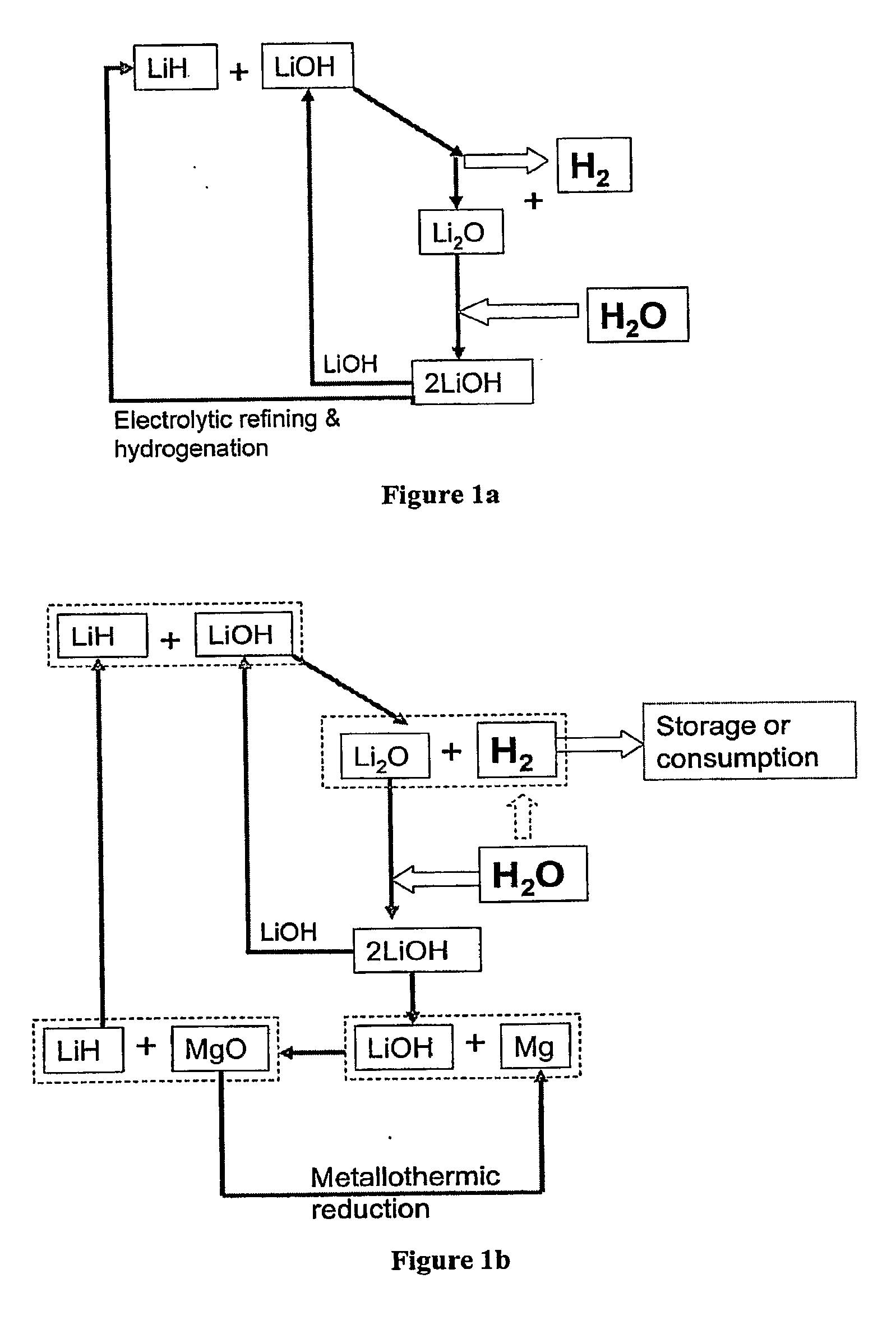Systems and Methods for Hydrogen Storage and Generation from Water Using Lithium Based Materials
- Summary
- Abstract
- Description
- Claims
- Application Information
AI Technical Summary
Benefits of technology
Problems solved by technology
Method used
Image
Examples
example 1
[0105]The starting materials, lithium hydroxide (LiOH, 98%), lithium hydroxide monohydrate (LiOH.H2O, 98%), lithium hydride (LiH, 95%), magnesium powder (Mg, 98%) were purchased from Aldrich Chemical. All of the starting materials were used as received without any further purification. To prevent samples and raw materials from undergoing oxidation and / or hydroxide formation, they were stored and handled in an argon-filled glove box.
[0106]All the mixtures were mechanically milled in an SPEX 8000 high-energy mill under argon atmosphere for 30 min. After milling, the samples were transferred to a glove box. The thermal hydrogen release properties of the mixtures were determined by a thermogravimetry analyzer (TGA) (Shimadzu TGA50) upon heating to 350° C. at a heating rate of 5° C. / min. To avoid any exposure of the sample to air, this equipment was set inside the argon-filled glove box equipped with a recirculation system.
[0107]The identification of reactants and reaction products in th...
example 2
[0108]Equation (1) was carried out by mixing LiH and LiOH powder using a mortar and pestle. The mixed powder was then placed in the thermogravimetric analysis (TGA) instrument. FIG. 9 shows the hydrogen evolution from mechanically milled mixtures of LiH / LiOH during heating up to 350° C. The sample was run under argon atmosphere with a heating rate of 2° C. / min. Temperatures were held constant at time points when there was definitive weight loss, indicating a decomposition reaction, and until the reaction step was complete. It can be seen that a total of 6.0 wt % of hydrogen was released within the examined temperature range, and the majority occurred before 240° C. Assuming complete dehydrogenation of LiOH / LiH mixture, the maximum amount of H2 produced would be about 6.25 wt. %. So, the hydrogen collected represents a yield as high as 96%.
[0109]X-ray diffraction analysis was carried out on the raw materials as well as on the reaction products. Crystalline phases were identified by c...
example 3
[0110]In order to assess the energetic viability of the proposed technology, a preliminary energy balance calculation based on a conservative situation of not recovering heat from the hot products has been carried out by assuming Equation (8) is carried out at 1300° C. The energy required for production of one mole of H2 is 454kJ. Because the heat of combustion of H2 gas is 286 kJ / mol, the energy content of H2 is 63% of the energy required for regeneration. This more than satisfies the requirement set by DOE for off-board regenerated storage materials. Those results were compared with additional technologies. The results are in Table 1.
TABLE 1Candidate MaterialsOn-board reversible Metal HydrideMgH2Chemical HydridesdopedNaBH4Proposed MethodPropertiesw / NiNaAlH4LiH + LiNH2½MgH2 + LiBH4HydrolysisLiH + H2OPotential7.65.66.511.46.411.8reversible wt %H2Temp. of Release200~300180-220200~300450Room temp.Room temp. to (° C.)Rate of ReleaseSlowGoodGoodSlowExtremely fastGoodRate ofSlowGoodGoodS...
PUM
| Property | Measurement | Unit |
|---|---|---|
| Temperature | aaaaa | aaaaa |
| Temperature | aaaaa | aaaaa |
| Temperature | aaaaa | aaaaa |
Abstract
Description
Claims
Application Information
 Login to View More
Login to View More - R&D
- Intellectual Property
- Life Sciences
- Materials
- Tech Scout
- Unparalleled Data Quality
- Higher Quality Content
- 60% Fewer Hallucinations
Browse by: Latest US Patents, China's latest patents, Technical Efficacy Thesaurus, Application Domain, Technology Topic, Popular Technical Reports.
© 2025 PatSnap. All rights reserved.Legal|Privacy policy|Modern Slavery Act Transparency Statement|Sitemap|About US| Contact US: help@patsnap.com



